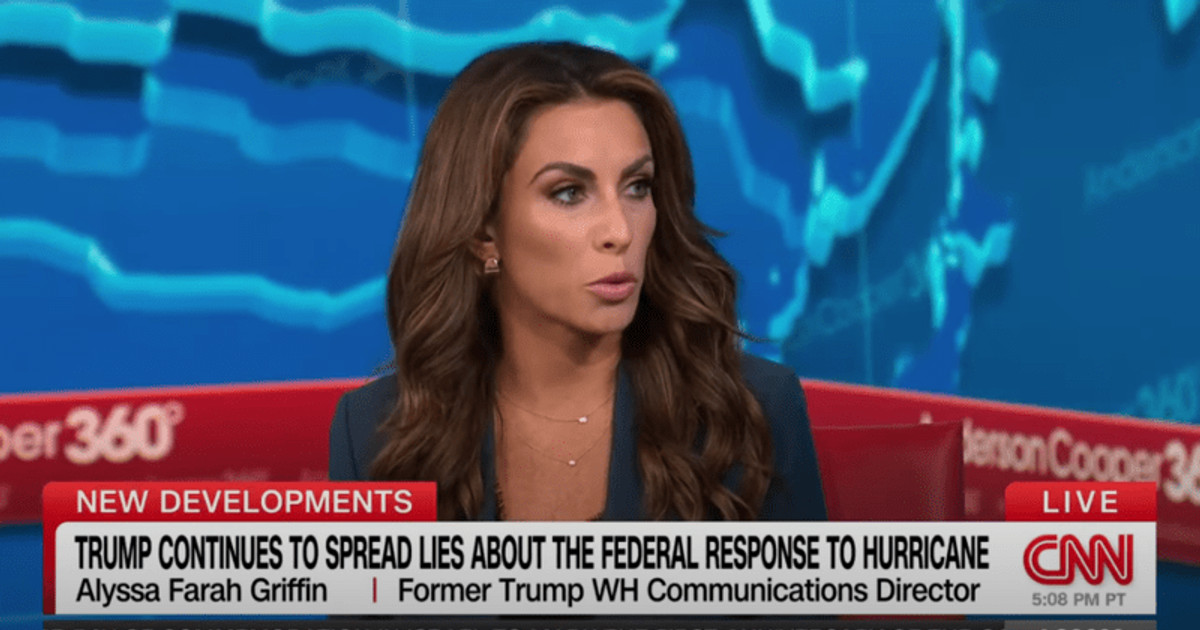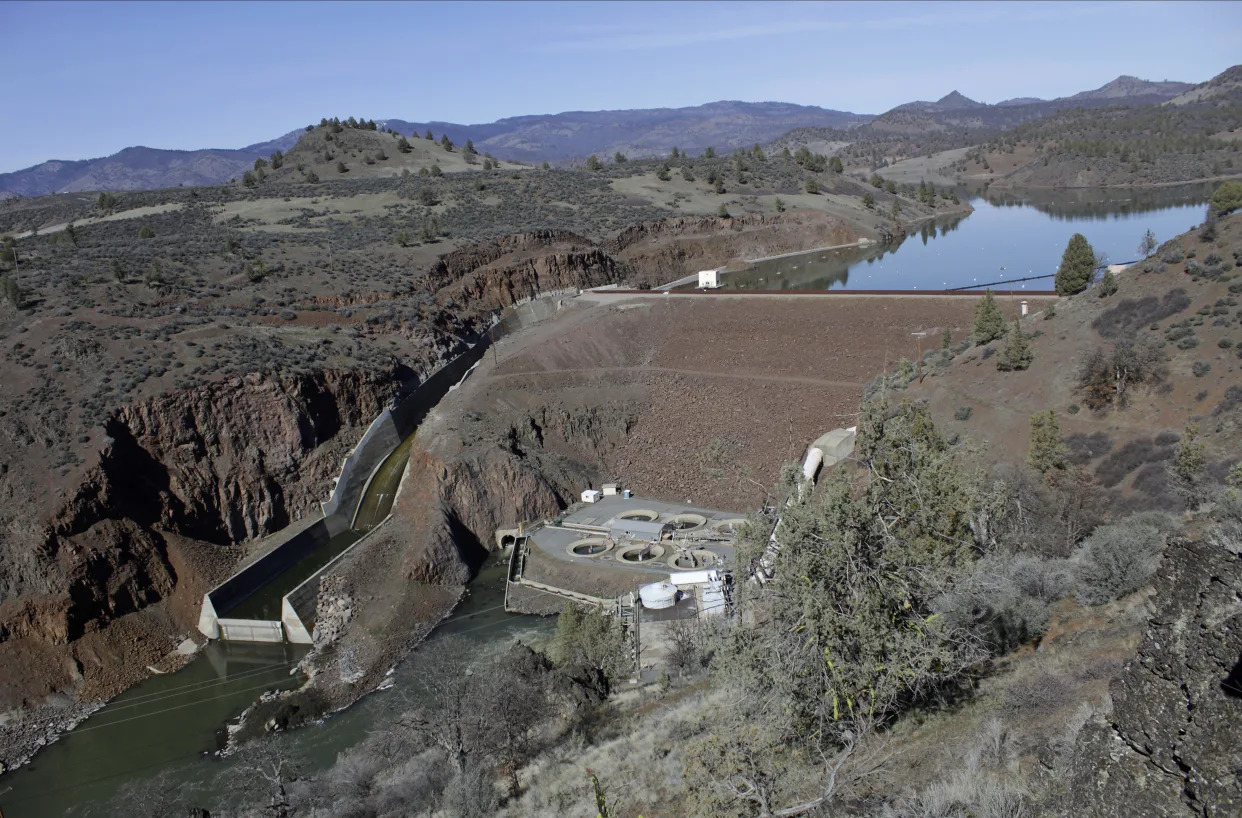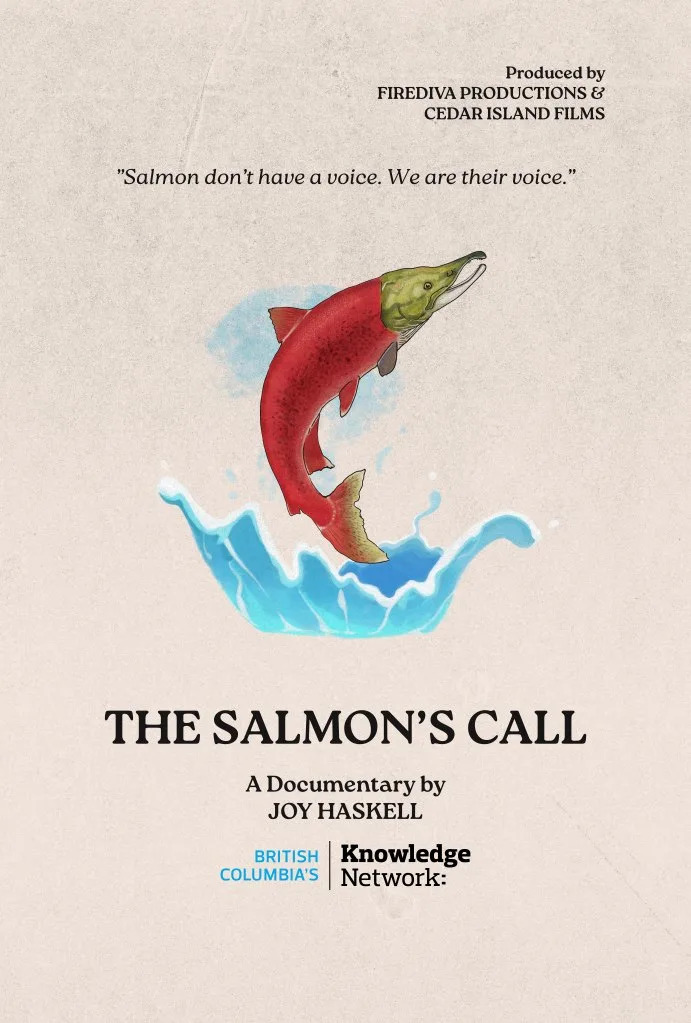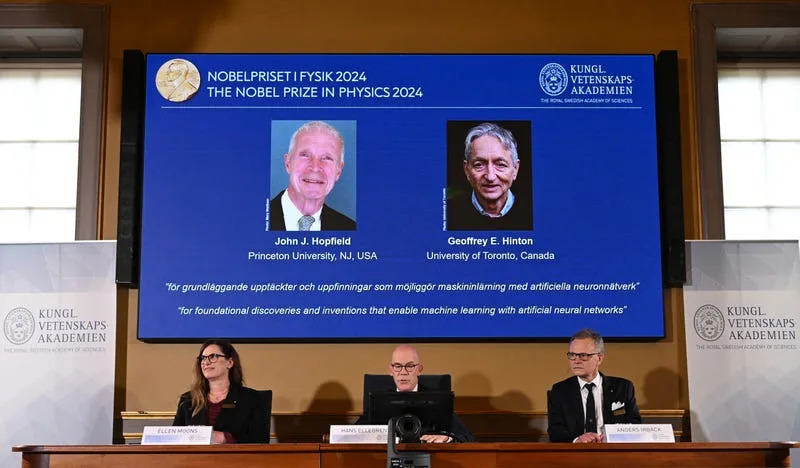North Carolina Gov. Roy Cooper, right, and Deanne Criswell, Administrator of the U.S. Federal Emergency Management Agency, await the arrival of Democratic presidential nominee Vice President Kamala Harris for a briefing on the damage from Hurricane Helene, at Charlotte Douglas International Airport, Oct. 5, 2024, in Charlotte, N.C. (AP Photo/Chris Carlson, file)Read More
A worker cuts up a tree that impaled itself on a fire hydrant during Hurricane Helene, Friday, Oct. 4, 2024, in the Oak Forest neighborhood of Asheville, N.C. (AP Photo/Jeff Amy)
Contractors for Duke Energy rebuild destroyed electrical lines near the Swannanoa River in Asheville, N.C., Friday, Oct. 4, 2024. (AP Photo/Jeff Amy)
Tennessee Gov. Bill Lee visits with a volunteer at the East Tennessee Disaster Relief Center, for Hurricane Helene disaster response Monday, Oct. 7, 2024, in Bristol, Tenn. (AP Photo/George Walker IV via Pool)
Volunteer Ann Davis speaks with Tennessee Gov. Bill Lee, right, during his visit to the East Tennessee Disaster Relief Center, for Hurricane Helene disaster response Monday, Oct. 7, 2024, in Bristol, Tenn. (AP Photo/George Walker IV via Pool)
BY JOHN RABY AND GABRIELA AOUN ANGUEIRA
October 7, 2024
LAKE LURE, N.C. (AP) — The head of the U.S. disaster response agency continued to forcefully push back Monday against false claims and conspiracy theories about her agency’s response to Hurricane Helene as the death toll from the storm continued to climb.
Federal Emergency Management Agency Administrator Deanne Criswell pointed to the agency’s massive, collaborative effort that keeps growing, and she strongly urged residents in hard-hit areas to accept the government’s offer for assistance.
“We have thousands of people on the ground, not just federal, but also our volunteers in the private sector,” Criswell said at a news conference in Asheville, North Carolina. “And frankly, that type of rhetoric is demoralizing to our staff that have left their families to come here and help the people of North Carolina. And we will be here as long as they’re needed.”
Misinformation has spread over the past week in communities hit the hardest by Helene, including that the federal government is intentionally withholding aid to people in Republican areas. Former President Donald Trump and other Republicans have questioned FEMA’s response and falsely claimed that its funding is going to migrants or foreign wars.
RELATED STORIES
Death toll rises from Helene while supplies are rushed to North Carolina
Helene's aftermath: Supplies arrive in North Carolina as death toll tops 130
FEMA has dedicated part of its website to providing accurate answers to questions and addressing rumors on its response to Helene.
On Friday, the agency put out a statement debunking rumors that it will only provide $750 to disaster survivors to support their recovery. Criswell said that initial money helps residents with expenses for medicine or food. She said additional funding will be available to reimburse them for the cost of home repairs, personal items lost, post-hurricane rental units and hotel stays.
“But I can’t give it to them if they don’t apply,” Criswell said. “And if people are afraid to apply, then it is hurting them.”
When asked directly about a circulating claim that FEMA would seize people’s property if they don’t pay back the $750 in within one year, Criswell said that was “absolutely false.”
The cleanup and response to the storm that killed at least 230 people continued Monday, while Milton strengthened rapidly into a Category 5 hurricane on a path toward Florida, the same area battered by Helene less than two weeks ago.
More than 130,000 customers in western North Carolina were still without electricity Monday, according to poweroutage.us.
Also in North Carolina, more than 1,600 local and state search-and-rescue team members have been joined by about 1,700 members of the state National Guard, according to Gov. Roy Cooper’s office.
Meanwhile, the Pentagon said Monday that an additional 500 active-duty troops have been deployed to North Carolina. Maj. Gen. Pat Ryder, the Pentagon press secretary, said troops with advanced technological assets will be arriving, bringing the total number of active-duty forces to about 1,500. The troops are bringing surveillance equipment to allow officials to get a better overview of the region.
Air Force Gen. Gregory Guillot, commander of the North American Aerospace Defense Command, said search-and-rescue aircraft were flying 10-hour sorties providing wellness checks, medical care and evacuations. He called the military’s operations the “most important and honorable mission for us, which is to help fellow citizens.”
Cooper said more than 50 water systems were destroyed or impaired by the storm and that the pace of restoring service varies by community. He said he couldn’t give a specific timeline but said the process might take longer in Asheville and Buncombe County, where at least six dozen people died.
“It’s still going to be a while,” he said.
Cooper also visited the towns of Chimney Rock and Lake Lure in Rutherford County, which both experienced devastating damage.
“We’re going to help western North Carolina come back,” Cooper said as he stood with Lake Lure’s mayor, Carol Pritchett. “It’s too important to our economy, to our state, not to do it.”
Pritchett told Cooper that the tiny town would need all the help it could get. Its sewer and wastewater treatment systems needed complete replacements, and the lake would have to be completely dredged. She estimated the costs would be in the tens of millions of dollars.
“We’re a town of 1,300; we certainly can’t do it on our own,” Pritchett said.
Without restoring major infrastructure, Pritchett said the tourism on which the town depends could not come back.
“The town’s name is Lake Lure. With no lake here, the ‘Lake Lure’ kind of begs the question,” she said.
In South Carolina, officials estimate $250 million has been spent on debris cleanup, infrastructure damage and emergency response. More than 300 homes were destroyed and 5,200 damaged, state Emergency Management Division Director Kim Stenson said Monday.
The state’s largest school district, Greeneville County, plans to reopen Wednesday after shutting down for seven days. The district said it has had to modify bus routes because of blocked roads, closed bridges, sinkholes, and traffic signal outages at major intersections.
In Tennessee, where at least 12 people died from Helene, Gov. Bill Lee on Monday visited Bristol Motor Speedway, now a hub for collecting donations for victims and centralizing other operations in the wake of the flooding. Lee met with coordinators and volunteers who were sorting through donations.
“These are Tennesseans and they’re hurting,” Lee said. “Not only are they hurting, but they’re helping.”
___
Associated Press writers Lolita C. Baldor, Jeffrey Collins and George Walker contributed to this report.
US disaster relief chief blasts false claims about Helene response as a ‘truly dangerous narrative’

President Joe Biden talks with Deanne Criswell, Administrator of the Federal Emergency Management Agency (FEMA), as he arrives at Greenville-Spartanburg International Airport in Greer, S.C., Wednesday, Oct. 2, 2024, to survey damage from Hurricane Helene. (AP Photo/Susan Walsh)
BY FARNOUSH AMIRI
October 6, 2024
WASHINGTON (AP) — The U.S. government’s top disaster relief official said Sunday that false claims and conspiracy theories about the federal response to Hurricane Helene — spread most prominently by Donald Trump — are “demoralizing” aid workers and creating fear in people who need recovery assistance.
“It’s frankly ridiculous, and just plain false. This kind of rhetoric is not helpful to people,” said Deanne Criswell, who leads the Federal Emergency Management Agency. “It’s really a shame that we’re putting politics ahead of helping people, and that’s what we’re here to do. We have had the complete support of the state,” she said, referring to North Carolina.
Republicans, led by the former president, have helped foster a frenzy of misinformation over the past week among the communities most devastated by Helene, promoting a number of false claims, including that Washington is intentionally withholding aid to people in Republican areas.
Trump accused FEMA of spending all its money to help immigrants who are in the United States illegally, while other critics assert that the government spends too much on Israel, Ukraine and other foreign countries.
RELATED STORIES

Harris slams 'incredibly irresponsible' Trump over Hurricane Helene misinformation

Trump slams US response to Helene. His own disaster-response record is marked by politics
“FEMA absolutely has enough money for Helene response right now,” Keith Turi, acting director of FEMA’s Office of Response and Recovery said. He noted that Congress recently replenished the agency with $20 billion, and about $8 billion of that is set aside for recovery from previous storms and mitigation projects.
There also are outlandish theories that include warnings from far-right extremist groups that officials plan to bulldoze storm-damaged communities and seize the land from residents. A falsehood pushed by Rep. Marjorie Taylor Greene, R-Ga., asserts that Washington used weather control technology to steer Helene toward Republican voters in order to tilt the presidential election toward Democrat Kamala Harris.
Criswell said on ABC’s “This Week” that such baseless claims around the response to Helene, which caused catastrophic damage from Florida into the Appalachian mountains and a death toll that rose Sunday to at least 230, have created a sense of fear and mistrust from residents against the thousands of FEMA employees and volunteers on the ground.
“We’ve had the local officials helping to push back on this dangerous -- truly dangerous narrative that is creating this fear of trying to reach out and help us or to register for help,” she said.
President Joe Biden said in a statement Sunday that his administration “will continue working hand-in-hand with local and state leaders –- regardless of political party and no matter how long it takes.”
Meantime, FEMA is preparing for Hurricane Milton, which rapidly intensified into a Category 1 storm on Sunday as it heads toward Florida.
“We’re working with the state there to understand what their requirements are going to be, so we can have those in place before it makes landfall,” she said.
President Joe Biden talks with Deanne Criswell, Administrator of the Federal Emergency Management Agency (FEMA), as he arrives at Greenville-Spartanburg International Airport in Greer, S.C., Wednesday, Oct. 2, 2024, to survey damage from Hurricane Helene. (AP Photo/Susan Walsh)
BY FARNOUSH AMIRI
October 6, 2024
WASHINGTON (AP) — The U.S. government’s top disaster relief official said Sunday that false claims and conspiracy theories about the federal response to Hurricane Helene — spread most prominently by Donald Trump — are “demoralizing” aid workers and creating fear in people who need recovery assistance.
“It’s frankly ridiculous, and just plain false. This kind of rhetoric is not helpful to people,” said Deanne Criswell, who leads the Federal Emergency Management Agency. “It’s really a shame that we’re putting politics ahead of helping people, and that’s what we’re here to do. We have had the complete support of the state,” she said, referring to North Carolina.
Republicans, led by the former president, have helped foster a frenzy of misinformation over the past week among the communities most devastated by Helene, promoting a number of false claims, including that Washington is intentionally withholding aid to people in Republican areas.
Trump accused FEMA of spending all its money to help immigrants who are in the United States illegally, while other critics assert that the government spends too much on Israel, Ukraine and other foreign countries.
RELATED STORIES

Harris slams 'incredibly irresponsible' Trump over Hurricane Helene misinformation
Trump slams US response to Helene. His own disaster-response record is marked by politics
“FEMA absolutely has enough money for Helene response right now,” Keith Turi, acting director of FEMA’s Office of Response and Recovery said. He noted that Congress recently replenished the agency with $20 billion, and about $8 billion of that is set aside for recovery from previous storms and mitigation projects.
There also are outlandish theories that include warnings from far-right extremist groups that officials plan to bulldoze storm-damaged communities and seize the land from residents. A falsehood pushed by Rep. Marjorie Taylor Greene, R-Ga., asserts that Washington used weather control technology to steer Helene toward Republican voters in order to tilt the presidential election toward Democrat Kamala Harris.
Criswell said on ABC’s “This Week” that such baseless claims around the response to Helene, which caused catastrophic damage from Florida into the Appalachian mountains and a death toll that rose Sunday to at least 230, have created a sense of fear and mistrust from residents against the thousands of FEMA employees and volunteers on the ground.
“We’ve had the local officials helping to push back on this dangerous -- truly dangerous narrative that is creating this fear of trying to reach out and help us or to register for help,” she said.
President Joe Biden said in a statement Sunday that his administration “will continue working hand-in-hand with local and state leaders –- regardless of political party and no matter how long it takes.”
Meantime, FEMA is preparing for Hurricane Milton, which rapidly intensified into a Category 1 storm on Sunday as it heads toward Florida.
“We’re working with the state there to understand what their requirements are going to be, so we can have those in place before it makes landfall,” she said.
'Field day for Russia': Ex-Trump staffer slams his 'gross' and 'dangerous' FEMA 'lies'
Daniel Hampton
October 7, 2024

A former White House communications director for Donald Trump ripped her old boss Monday over the MAGA leader's falsehoods relating to hurricane response in the aftermath of Hurricane Helene. (Screengrab via CNN)
A former White House communications director for Donald Trump ripped her old boss Monday over the MAGA leader's falsehoods relating to hurricane response in the aftermath of Hurricane Helene.
Alyssa Farah Griffin joined CNN anchor Anderson Cooper on Monday night to discuss the former president's false statements over the weekend that Helene victims were only receiving $750 in disaster relief.
"They send hundreds of billions of dollars to foreign nations. And you know what they're giving our people? 750 bucks," Trump told rally-goers in a clip shared on Cooper's show. He repeated the misleading statement in a second clip as Cooper noted that the $750 is "for immediate need."
"One form of aid, among others, that the government offers," Cooper said, noting the Federal Emergency Management Agency, or FEMA, now has a webpage dedicated to combatting false information.
In a second clip, Trump claims FEMA spent over $1 billion on sheltering "illegal migrants" and said the agency now has "no money" for states reeling from the storm.
Cooper then played a clip of Thom Tillis, the Republican senior senator of North Carolina, who told CBS News' "Face The Nation" that the Biden administration's immigration policies have not affected its hurricane response.
"Not at this time," said Tillis.
When Cooper asked Griffin her reaction to her former boss' remarks, she gave a blunt assessment.
"It's gross, but it's dangerous," she said.
Griffin said FEMA may have been the "most effective" at executing its job of all the agencies she's worked with.
"He knows this information isn't true and it has real-life consequences on the ground," said Griffin.
Volunteers are depressed due to fears they think there's not a need or they're unable to get where they need, she said. Additionally, FEMA is now spending resources to "knock down these lies," and there are people who need help who are being told the're no help to give, when "in fact, there are quite a lot of federal resources out there."
Moreover, America's adversaries "love this," she said.
"This is a field day for Russia and China who are then going to amplify on social media ahead of the election to tear us apart," she said. "Listen, everything becomes politicized a month out from an election, but this is a step further that I've never really seen something like this. When you're dealing with multiple horrible national natural disasters at the same time."
She added: "It shows Donald Trump is willing to go so low."
Watch the clip below or at this link.
Daniel Hampton
October 7, 2024

A former White House communications director for Donald Trump ripped her old boss Monday over the MAGA leader's falsehoods relating to hurricane response in the aftermath of Hurricane Helene. (Screengrab via CNN)
A former White House communications director for Donald Trump ripped her old boss Monday over the MAGA leader's falsehoods relating to hurricane response in the aftermath of Hurricane Helene.
Alyssa Farah Griffin joined CNN anchor Anderson Cooper on Monday night to discuss the former president's false statements over the weekend that Helene victims were only receiving $750 in disaster relief.
"They send hundreds of billions of dollars to foreign nations. And you know what they're giving our people? 750 bucks," Trump told rally-goers in a clip shared on Cooper's show. He repeated the misleading statement in a second clip as Cooper noted that the $750 is "for immediate need."
"One form of aid, among others, that the government offers," Cooper said, noting the Federal Emergency Management Agency, or FEMA, now has a webpage dedicated to combatting false information.
In a second clip, Trump claims FEMA spent over $1 billion on sheltering "illegal migrants" and said the agency now has "no money" for states reeling from the storm.
Cooper then played a clip of Thom Tillis, the Republican senior senator of North Carolina, who told CBS News' "Face The Nation" that the Biden administration's immigration policies have not affected its hurricane response.
"Not at this time," said Tillis.
When Cooper asked Griffin her reaction to her former boss' remarks, she gave a blunt assessment.
"It's gross, but it's dangerous," she said.
Griffin said FEMA may have been the "most effective" at executing its job of all the agencies she's worked with.
"He knows this information isn't true and it has real-life consequences on the ground," said Griffin.
Volunteers are depressed due to fears they think there's not a need or they're unable to get where they need, she said. Additionally, FEMA is now spending resources to "knock down these lies," and there are people who need help who are being told the're no help to give, when "in fact, there are quite a lot of federal resources out there."
Moreover, America's adversaries "love this," she said.
"This is a field day for Russia and China who are then going to amplify on social media ahead of the election to tear us apart," she said. "Listen, everything becomes politicized a month out from an election, but this is a step further that I've never really seen something like this. When you're dealing with multiple horrible national natural disasters at the same time."
She added: "It shows Donald Trump is willing to go so low."
Watch the clip below or at this link.
















